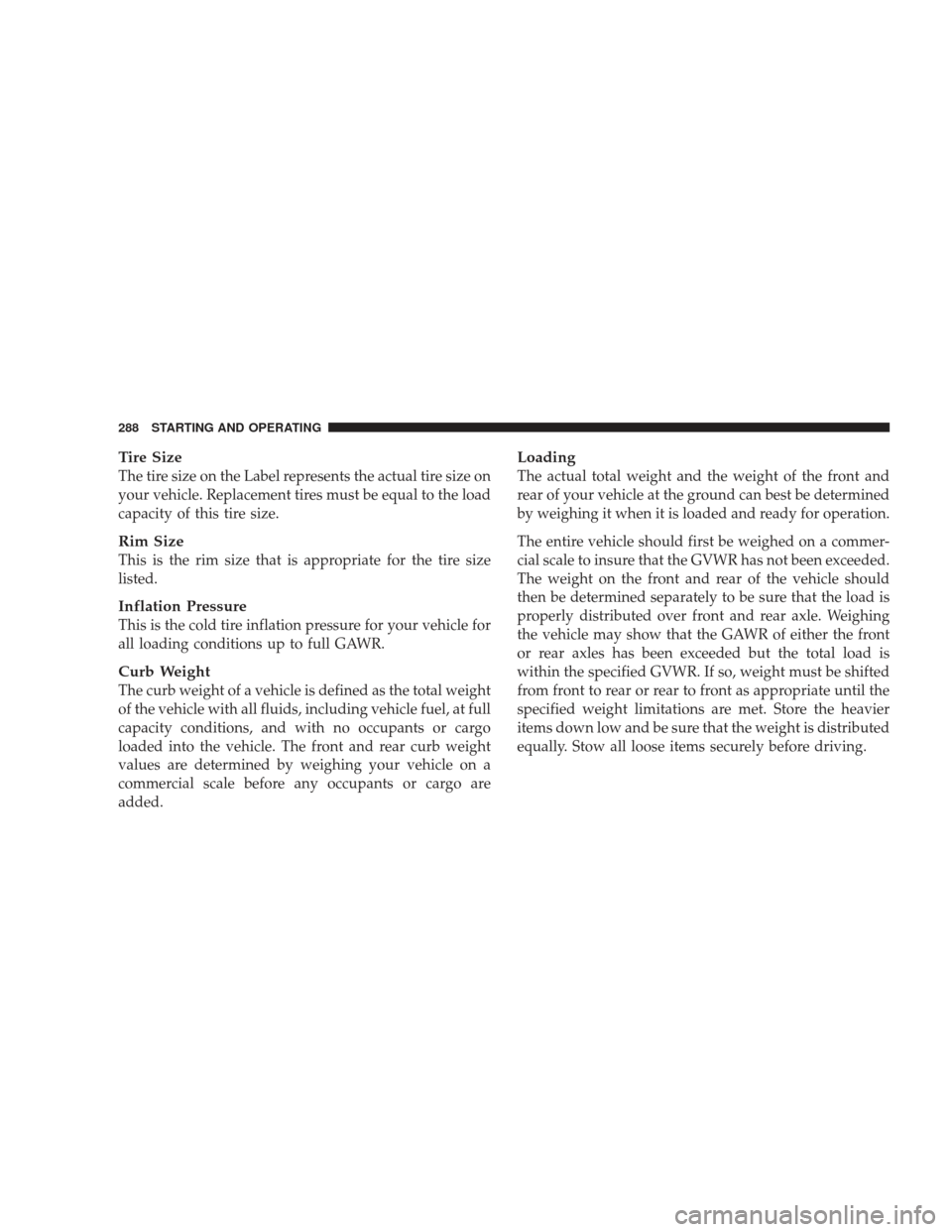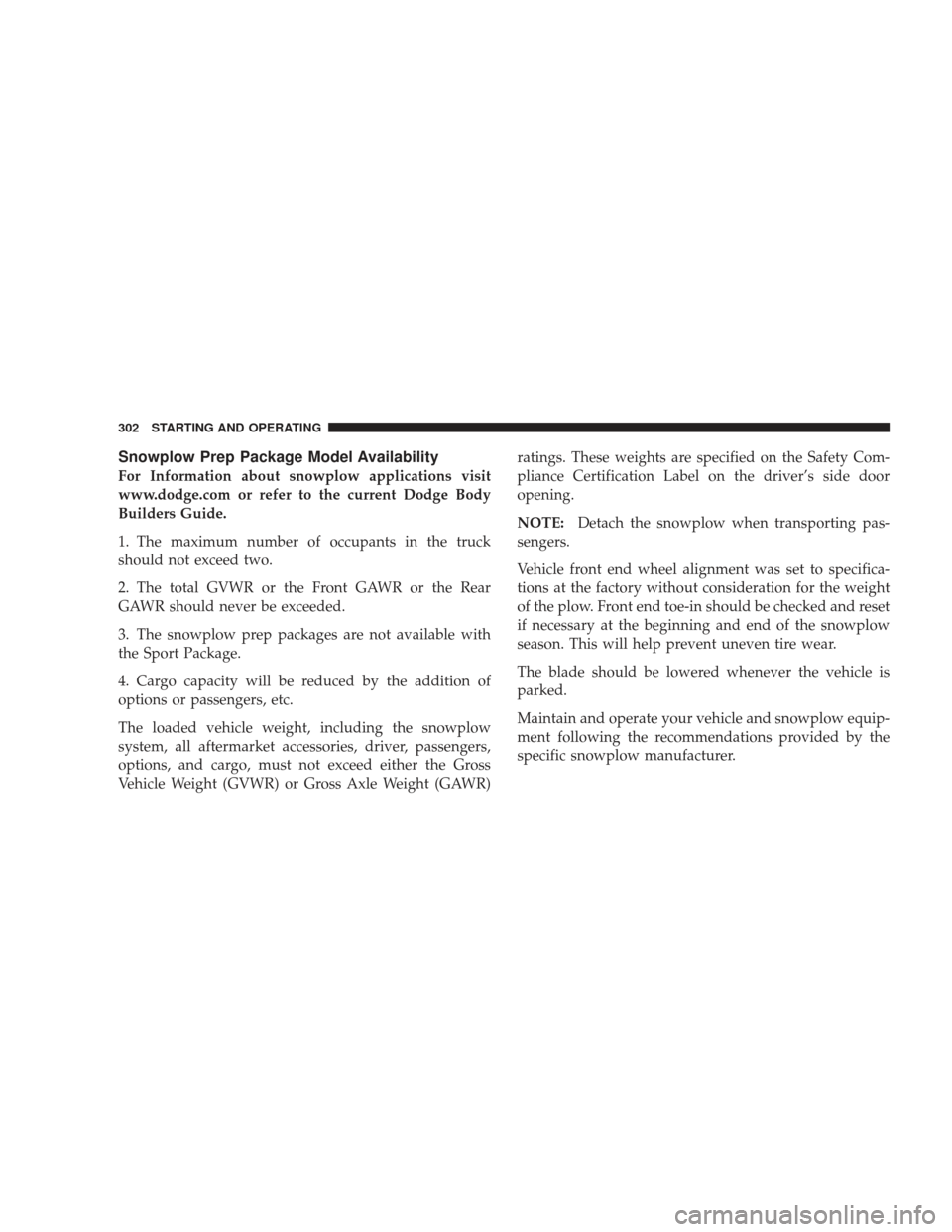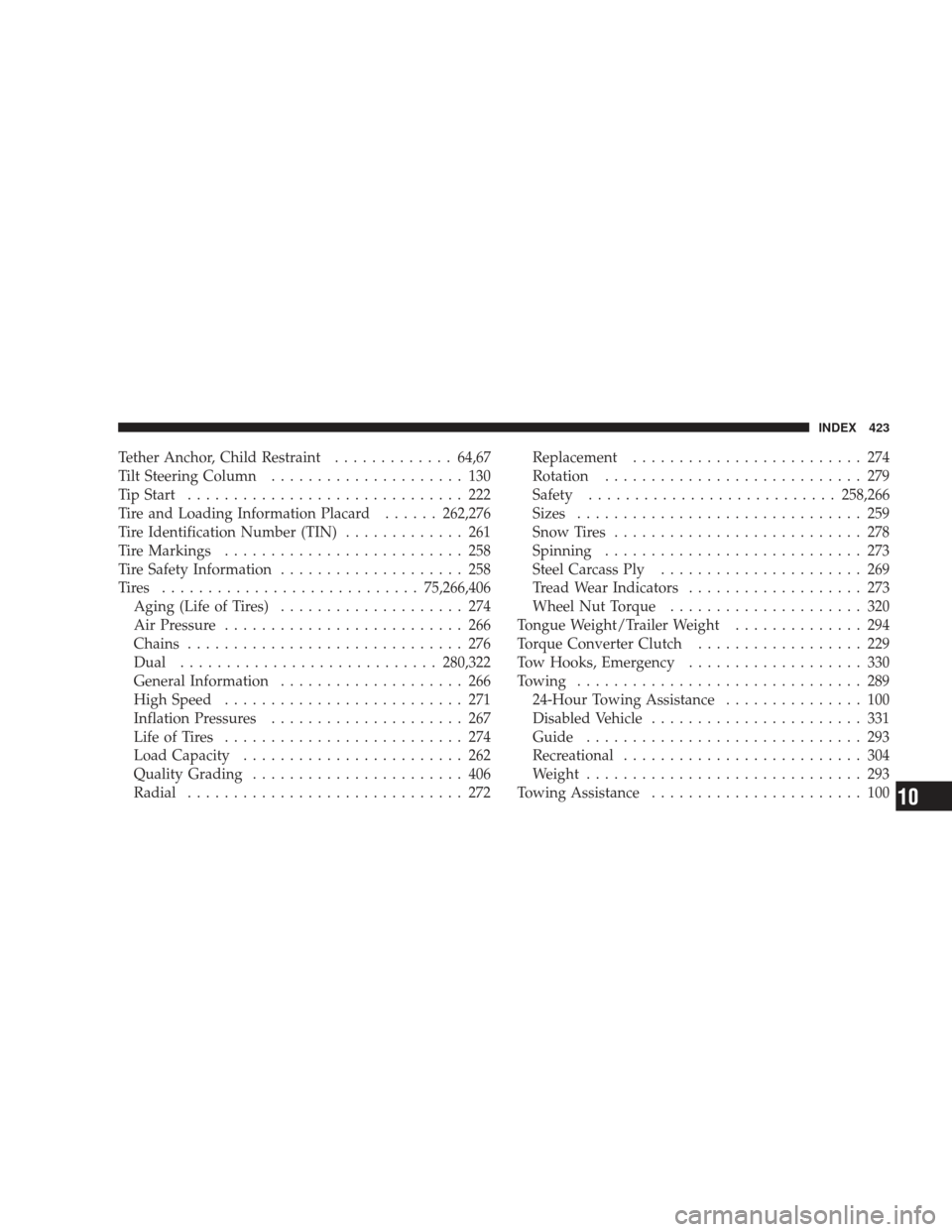Page 290 of 429

Tire Size
The tire size on the Label represents the actual tire size on
your vehicle. Replacement tires must be equal to the load
capacity of this tire size.
Rim Size
This is the rim size that is appropriate for the tire size
listed.
Inflation Pressure
This is the cold tire inflation pressure for your vehicle for
all loading conditions up to full GAWR.
Curb Weight
The curb weight of a vehicle is defined as the total weight
of the vehicle with all fluids, including vehicle fuel, at full
capacity conditions, and with no occupants or cargo
loaded into the vehicle. The front and rear curb weight
values are determined by weighing your vehicle on a
commercial scale before any occupants or cargo are
added.
Loading
The actual total weight and the weight of the front and
rear of your vehicle at the ground can best be determined
by weighing it when it is loaded and ready for operation.
The entire vehicle should first be weighed on a commer-
cial scale to insure that the GVWR has not been exceeded.
The weight on the front and rear of the vehicle should
then be determined separately to be sure that the load is
properly distributed over front and rear axle. Weighing
the vehicle may show that the GAWR of either the front
or rear axles has been exceeded but the total load is
within the specified GVWR. If so, weight must be shifted
from front to rear or rear to front as appropriate until the
specified weight limitations are met. Store the heavier
items down low and be sure that the weight is distributed
equally. Stow all loose items securely before driving.
288 STARTING AND OPERATING
Page 292 of 429

measure GTW is to put your fully loaded trailer on a
vehicle scale. The entire weight of the trailer must be
supported by the scale.
Gross Combination Weight Rating (GCWR)
The GCWR is the total permissible weight of your vehicle
and trailer when weighed in combination. (Note that
GCWR ratings include a 150 lbs (68 kg) allowance for the
presence of a driver).
Gross Axle Weight Rating (GAWR)
The GAWR is the maximum capacity of the front and rear
axles. Distribute the load over the front and rear axles
evenly. Make sure that you do not exceed either front or
rear GAWR.
WARNING!
It is important that you do not exceed the maximum
front or rear GAWR. A dangerous driving condition
can result if either rating is exceeded. You could lose
control of the vehicle and have an accident.
Tongue Weight (TW)
The tongue weight is the downward force exerted on the
hitch ball by the trailer is the tongue weight. In most
cases it should not be less than 10% or more than 15% of
the trailer load. You must consider this as part of the load
on your vehicle.
Frontal Area
The frontal area is the maximum height and maximum
width of the front of a trailer.
290 STARTING AND OPERATING
Page 299 of 429

�Also, check the trailer tires for proper tire inflation
pressures before trailer usage.
�Check for signs of tire wear or visible tire damage
before towing a trailer. Refer to “Tires–General Infor-
mation” in this section.
�When replacing tires, refer to “Tires–General Informa-
tion” in this section. Replacing tires with a higher load
carrying capacity will not increase the vehicle’s GVWR
and GAWR limits.
Towing Requirements — Trailer Brakes
�
Do not interconnect the hydraulic brake system or
vacuum system of your vehicle with that of the trailer.
This could cause inadequate braking and possible
personal injury.
�An electronically actuated trailer brake controller is
required when towing a trailer with electronically actuated brakes. When towing a trailer equipped with
a hydraulic surge actuated brake system, an electronic
brake controller is not required.
�Trailer brakes are recommended for trailers over
1,000 lbs (454 kg) and required for trailers in excess of
2,000 lbs (907 kg).
CAUTION!
If the trailer weighs more than 1,000 lbs (454 kg)
loaded, it should have its own brakes and they
should be of adequate capacity. Failure to do this
could lead to accelerated brake lining wear, higher
brake pedal effort, and longer stopping distances.
STARTING AND OPERATING 297
5
Page 304 of 429

Snowplow Prep Package Model Availability
For Information about snowplow applications visit
www.dodge.com or refer to the current Dodge Body
Builders Guide.
1. The maximum number of occupants in the truck
should not exceed two.
2. The total GVWR or the Front GAWR or the Rear
GAWR should never be exceeded.
3. The snowplow prep packages are not available with
the Sport Package.
4. Cargo capacity will be reduced by the addition of
options or passengers, etc.
The loaded vehicle weight, including the snowplow
system, all aftermarket accessories, driver, passengers,
options, and cargo, must not exceed either the Gross
Vehicle Weight (GVWR) or Gross Axle Weight (GAWR)ratings. These weights are specified on the Safety Com-
pliance Certification Label on the driver’s side door
opening.
NOTE:
Detach the snowplow when transporting pas-
sengers.
Vehicle front end wheel alignment was set to specifica-
tions at the factory without consideration for the weight
of the plow. Front end toe-in should be checked and reset
if necessary at the beginning and end of the snowplow
season. This will help prevent uneven tire wear.
The blade should be lowered whenever the vehicle is
parked.
Maintain and operate your vehicle and snowplow equip-
ment following the recommendations provided by the
specific snowplow manufacturer.
302 STARTING AND OPERATING
Page 416 of 429

Fabric Care............................ 361
Filters Air Cleaner .......................... 340
Engine Fuel .......................... 378
Engine Oil ..................... 338,340,378
Flashers Turn Signal .......................... 127
Flat Tire Stowage ........................ 326
Flooded Engine Starting ................... 222
Fluid, Brake ........................... 379
Fluid Capacities ......................... 377
Fluid Level Checks Brake .............................. 353
Manual Transmission ................... 356
Power Steering ........................ 253
Transfer Case ......................... 356
Fluids, Lubricants and Genuine Parts .......... 378
Fog Lights ....................... 126,167,374
Fold Flat Load Floor ..................... 154 Four Wheel Drive
....................... 230
Four-Way Hazard Flasher .................. 314
Freeing A Stuck Vehicle ................... 330
Front Axle (Differential) ................... 355
Fuel ................................. 281
Adding ............................. 285
Diesel .............................. 378
Filler Cap (Gas Cap) .................... 286
Filter ............................... 378
Gauge .............................. 171
Light ............................... 172
Octane Rating ........................ 281
Requirements ......................... 281
Tank Capacity ........................ 377
Fuses ................................ 364
Gas Cap (Fuel Filler Cap) ...............286,336
Gasoline (Fuel) ......................... 281
Gasoline, Reformulated ................... 281
414 INDEX
Page 425 of 429

Tether Anchor, Child Restraint.............64,67
Tilt Steering Column ..................... 130
Tip Start .............................. 222
Tire and Loading Information Placard ......262,276
Tire Identification Number (TIN) ............. 261
Tire Markings .......................... 258
Tire Safety Information .................... 258
Tires ............................ 75,266,406
Aging (Life of Tires) .................... 274
Air Pressure .......................... 266
Chains .............................. 276
Dual ............................ 280,322
General Information .................... 266
High Speed .......................... 271
Inflation Pressures ..................... 267
Life of Tires .......................... 274
Load Capacity ........................ 262
Quality Grading ....................... 406
Radial .............................. 272 Replacement
......................... 274
Rotation ............................ 279
Safety ........................... 258,266
Sizes ............................... 259
Snow Tires ........................... 278
Spinning ............................ 273
Steel Carcass Ply ...................... 269
Tread Wear Indicators ................... 273
Wheel Nut Torque ..................... 320
Tongue Weight/Trailer Weight .............. 294
Torque Converter Clutch .................. 229
Tow Hooks, Emergency ................... 330
Towing ............................... 289
24-Hour Towing Assistance ............... 100
Disabled Vehicle ....................... 331
Guide .............................. 293
Recreational .......................... 304
Weight .............................. 293
Towing Assistance ....................... 100
INDEX 423
10